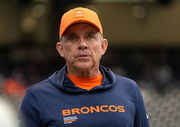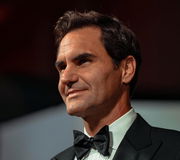

Grand Slam Track (GST) has been all over the headlines lately. And rightly so! It is after a revolutionary track and field league founded by Olympic legend Michael Johnson. GST will make its debut in April of 2025. So why revolutionary? One of the main reasons is the fact that, unlike most racing events in track and field, GST comes with a huge prize pool. Something that track legends and contemporary sprinters alike have supported. However, the fastest man seems to have some dissent!
Watch What’s Trending Now!
Noah Lyles since the 2024 Paris Olympics has spoken about two things. One is the lack of funding, and the other is the lack of marketing for athletes in track and field events. So ideally, Lyles should be happy about Grand Slam Track as it solves the funding and payment issues that track athletes faced for years. However, Lyles is far from happy about GST.
Lyles recently, in an interview with LetsRun.Com, went on to say, “[Grand Slam Track is] still in the same position [with me] as it has been all year.” And why is that? According to Lyles, “Being the Olympic champion, I’ve already come in with a lot of accolades and a lot of things where I don’t need monetary value, but I really need marketing value.” Part of the statement sounds insensitive, considering not everybody signing with GST has won an Olympic Gold or has the financial advantage that Lyles does. However, Lyles did just point out one of the biggest missing pieces still in GST!
ADVERTISEMENT
As Lyles rightly pointed out, Grand Slam Track is still yet to sign its broadcasting rights. And as Lyles puts it, “And if a tree falls in the woods… did it make a sound?”. So what is going on here? GST started with a $30 million investment, so they are in no hurry to find a partner; perhaps that’s the reason for the delay. But in the meantime, one of the platforms that’s going to stream the event has been announced. Citrus Mag will allegedly stream the event via their YouTube channel. But that’s not all!
Citrus Mag will also play a major role in creative storytelling in multiple formats. This will include podcasts, live shows, articles/newsletters, and social media. However, no firm broadcast deals or major media partnerships have been announced. This, according to Lyles, severely limits GST’s ability to deliver the visibility that top athletes like him need to grow their global brands. Noah Lyles is clearly pointing at larger issues in pro athletics.

Imago
LYLES Noah Team USA Olympiasieger 3.Tag Leichtathletik 100m Maenner Finale Paris Olympische Spiele 2024 04. 08. 2024 Paris *** LYLES Noah Team USA Olympic Champion 3 Day Athletics 100m Men Final Paris Olympic Games 2024 04 08 2024 Paris Copyright: xLacixPerenyix
Noah Lyles is talking about the balance between financial gain and market exposure. Now, while GST does position itself as a solution to track and field’s underwhelming pay structures, the lack of media clarity could undermine all the efforts. Johnson himself has highlighted GST’s mission to elevate athletes’ recognition to levels seen in mainstream sports like basketball and football. Yet, without a reliable TV partner, even the best marketing strategies could fail!
ADVERTISEMENT
And for GST, the stakes are rather high. They are going up against established circuits like the Diamond League and newer initiatives like World Athletics’ Ultimate Championship. Despite GST having all the right reasons, without a broadcast partner, bringing in big names like Noah Lyles or Sha’Carri Richardson can be a task. And without them, GST does risk a lower viewership. However, it is not all criticism. GST does have something else to offer!
ADVERTISEMENT
Grand Slam Track delivers value in other ways!
While Noah Lyles may have some reservations about GST, many other athletes don’t. The crème de la crème of tracks, including Sydney McLaughlin-Levrone, Fred Kerley, Josh Kerr, Masai Russell, and Kenny Bednarek, amongst others, have already signed with GST. Sydney, after signing with GST, even went on to say, “I think it’s just going to be really cool to see that dynamic and see the sport grow in popularity, and so I’m excited to be a part of that in any way.” But that’s not all!
Beyond the monetary benefits, GST has some other things, too. GST offers participants access to a group licensing program, fan data analytics tools, and creative support to build their personal brands. These are amenities unheard of in traditional athletic circuits. So what about the media? “We will certainly embrace all forms of media—traditional and new,” Johnson explained. In fact, their experimentation seems to be working, too. So how are they doing it?
ADVERTISEMENT
View this post on Instagram
To understand the same, let’s look at what GST did for media day. Media day, in itself, is something that is rare for track and field athletes. Usually, it is seen at the collegiate level, and unlike other sports, professional track athletes seldom experience such events. This leaves a big gap in invisibility and promotion. However, GST managed to bridge the same. GST collaborated with content creator and journalist Tiara Williams to launch a talk show called Spill the Tee. So why do that?
Top Stories
Sean Payton Announces Retirement Plans as Broncos HC Demands Improvement From Bo Nix & Co. Before Playoffs

Greg Biffle’s $4M Worth Prized Possession Still Without a Buyer Leaves NASCAR Fans Heartbroken

LIV Golf Braces for Another Possible Exit in Wake of Brooks Koepka Departure

Biff Poggi All But Confirms Bryce Underwood’s Michigan Future After Announcing His Own Departure

Roger Federer Draws Criticism from Swiss Government Chief for Tourism Boom in Country

NASCAR World Mourns as Former Watkins Glen President Michael Printup Passes Away at 60

Well, historically, athletes are known to be relaxed and authentic on William’s talk shows. Additionally, the lack of connection with evolving times has been one of the track downfalls. And through her interviews, GST solves the issue of connection. Williams has been known to bring out a new side of athletes that put forth their personalities and create a stronger connection with fans. Now, this can be huge considering William’s following and already proven skills.
ADVERTISEMENT
GST’s holistic approach is clearly designed to benefit athletes on and off the track. And while their methods may not be conventional, they seem to be working for now. With all said and done, there is no denying that GST still has the potential to revolutionize how people consume track and field.
ADVERTISEMENT
ADVERTISEMENT
ADVERTISEMENT

